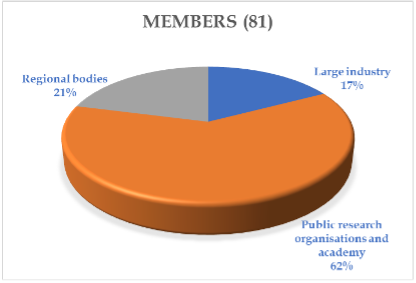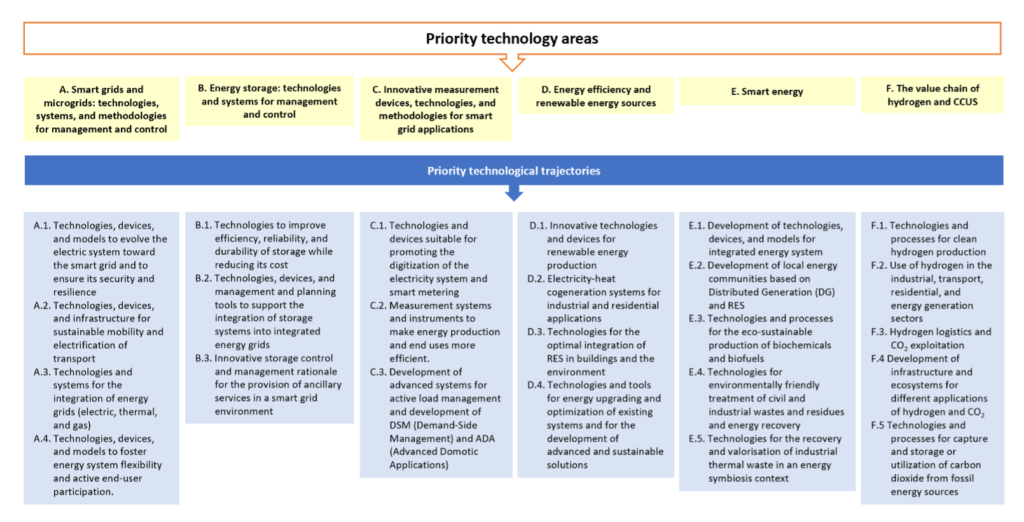CTN Energia – National Energy Technology Cluster
History of National Technology Clusters – CTN
The National Technology Clusters – CTN are public/private non-profit partnerships operating on the national territory for industrial research, training, and technology transfer, with the aim of coordinating and strengthening the link between the research and the industrial world through national and international initiatives.
Twelve National Technology Clusters are currently operating, created in two distinct timeframes.
In 2012 CTN Aerospace, Agrifood, Green Chemistry, Intelligent factories, Transports, Life sciences, Technologies for living environments, Smart Communities were recognized as national bodies by the Ministry of the University and the Research, and four years later, in 2019 CTN Energia, along with Made in Italy, Economy of the sea, Cultural heritage were recognized as well.
Basic Role and Members
The mission of CTN Energia is to combine the demand for innovation in the industrial sector with the scientific and technical outcome provided by the research infrastructures of the country to support the energy transition and therefore the achievement of the targets set by the European Union and the SET Plan, and at national level by the PNIEC (National Energy and Climate Plan), through research funding: Horizon Europe, PNRR(National Plan for Recovery and Resilience, using Next Generation EU funds), PNR (National Program for Research), RDSE (Research Programme for Energy Systems’), Mission Innovation, IPCEI (Important Projects of Common European Interest) and National and Regional Calls.
The CTN Energia Founders are representative of public research organisations (ENEA, CNR, RSE), the industry (e-distribuzione, ENI, NUOVO PIGNONE TECNOLOGIE, TERNA), and the academy (EnSiEL).
 The Cluster counts today around eigthy Members, representative of regional bodies (some of which – territorial district/cluster – represent numerous SME), large industries, public research organisations and Academy.
The Cluster counts today around eigthy Members, representative of regional bodies (some of which – territorial district/cluster – represent numerous SME), large industries, public research organisations and Academy.
The CTN Energia is managed by the Board of Directors chaired by the Presidentand supported by the Director of the Technical Secretariat. In addition, the Scientific-Technical Committee (STC) and three thematic committees, representing the different typologies of members, complete the governance structure with the following tasks. The Scientific-Technical Committee members contribute to perfecting and updating the technology and development roadmap and its research trajectories, in line with national, European and international directions, the Industry Committee contributes to the definition of research, development and industrial innovation strategies and promotes technology transfer and the launch of start-ups and research spin-offs; the Institutional Research Committeeparticipates in the development and proposal of strategies for research and innovation in the energy sector and assists the industry in technology transfer and the Regional Bodies Committee provides support to the formulation of research strategies ensuring they are consistent with the regional research policies.
Pilot Projects
Two pilot projects were also funded under the Cluster umbrella, related to industrial research, having as objectives the development of knowledge, technological solutions and innovative applications in activities related to two specific strategic lines:
- innovative components and systems for the production and distribution of sustainable and low-carbon energy;
- production, storage and distribution of electricity according to the Smart grid concept
The projects focused on experimental and industrial research works suitable to enhance the links between public and private research and demonstrate the ability to create value from the partnership collaboration and were carried out by the Cluster founders.
NeMESi Project: New Sustainable Energy Mixing
The project aimed at studying and developing advanced solutions in the CSP (Concentrated Solar Power) sector and their hybridization and integration with other energy sources.
In particular, it addressed the evaluation of the benefits deriving from the integration of concentrated solar plants (equipped with innovative systems for thermal storage), with plants for the production of steam for industrial use and for the generation of electricity, identifying and defining at the same time the more convenient configurations and related optimization parameters.
Living Grid Project
The focus of the project was the development of new models for the optimal management, in emergency conditions, of the National Transmission Grid, of the disconnection and reconnection of portions of the grid and the related distributed energy resources.
Part of the project’s workplan was also the construction of a demonstrator/pilot capable of representing a technologically scalable system.
Three-year technology plan
The Cluster mission is implemented by means of a three-year technology plan, reviewed yearly to stay up to date with the evolving national, European and international energy policies, the members’ research and innovation priorities and the technology transfer programmes.
The current technology plan (2023) identifies six priority technological areas of interest, each of them associated to a few (3-5) representative technology trajectories.
- Smart grids and microgrids: technologies, systems, and methodologies for management and control
- Energy storage: technologies and systems for management and control
- Innovative measurement devices, technologies, and methodologies for smart grid applications
- Energy efficiency and renewable energy sources
- Smart energy
- The value chain of hydrogen and CCUS.
The technology trajectories deal with topics such as sustainable mobility, power-to-gas, integrated energy networks, digitalization and smart metering, energy storage management, energy production and end-use efficiency, energy production from renewable sources (solar, wind), RESs (Renewable Energy Sources) integration in buildings and the environment, local energy communities, biochemicals and biofuels, industrial symbiosis in the energy sector (energy recovery from thermal waste), hydrogen as energy vector, carbon capture utilization and storage CCUS (blue hydrogen), energy network integration and digitalization.
These areas are characterized by a different level of technological maturity, product innovation, patent activity and by the presence, in most cases, of an adequate and qualified national production sector, including its related allied industries. The latter, supported by targeted policies and strategies to support research and innovation, will be able to strengthen their position in the international market for Energy devices and systems, thus facilitating the energy transition to a low-carbon economy.

National Energy Technology Cluster’s day to day activities
CTN Energia coordinate actions both with the Cluster’s Members and also with other Associations and Clusters, industries, research centers to support the development of the technology trajectories of the roadmap; promote events and facilitate networking; participate in institutional activities: public consultations, auditions, working groups; act as expert advisor to governing bodies when deemed necessary, for example to ensure coherence among the regional and national smart specialization strategies.
